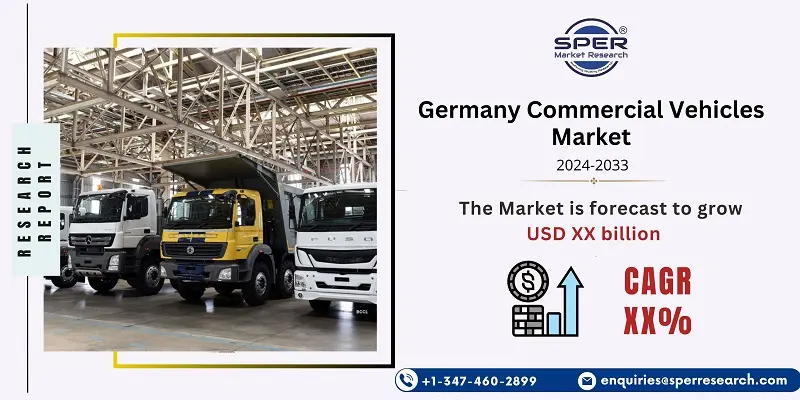
Germany Commercial Vehicles Market Growth, Size, Trends, Demand, Revenue and Future Outlook
Germany Commercial Vehicles Market Size- By Vehicle Type, By Fuel Type- Regional Outlook, Competitive Strategies and Segment Forecast to 2033
| Published: Jun-2024 | Report ID: AMIN24148 | Pages: 1 - 103 | Formats*: |
| Category : Automotive & Transportation | |||
- In 2022: The commercial trucking business of Volvo declared that its vehicles fueled by hydrogen fuel cells are now being tested. CellCentric, a joint venture between Volvo and Daimler Trucks, provides the fuel cells. Volvo boasts that their trucks have a 1,000-kilometer driving range and can be refueled in less than 15 minutes.


| Report Metric | Details |
| Market size available for years | 2020-2033 |
| Base year considered | 2023 |
| Forecast period | 2024-2033 |
| Segments covered | By Vehicle Type, By Fuel Type |
| Regions covered | Eastern Region, Western Region, Northern Region, Southern Region |
| Companies Covered | AB Volvo, Daimler AG, MAN Truck & Bus AG, IVECO Magirus AG, Renault Trucks Deutschland GmbH, Ford-Werke GmbH, Toyota Motor Corporation, Others. |
- Manufacturers
- Distributors
- Suppliers
- Investors
- Fleet Operators
- Government Regulators
- Industry Analysts
| By Vehicle Type: |
|
| By Fuel Type: |
|
| By Region: |
|
- Germany Commercial Vehicles Market Size (FY’2024-FY’2033)
- Overview of Germany Commercial Vehicles Market
- Segmentation of Germany Commercial Vehicles Market By Vehicle Type (Light Commercial Vehicles, Heavy Commercial Vehicles, Buses)
- Segmentation of Germany Commercial Vehicles Market By Fuel Type (I.C Engine, Electrical Vehicle)
- Expansion Analysis of Germany Commercial Vehicles Market
- Problems and Obstacles in Germany Commercial Vehicles Market
- Competitive Landscape in the Germany Commercial Vehicles Market
- Impact of COVID-19 and Demonetization on Germany Commercial Vehicles Market
- Details on Current Investment in Germany Commercial Vehicles Market
- Competitive Analysis of Germany Commercial Vehicles Market
- Prominent Players in the Germany Commercial Vehicles Market
- SWOT Analysis of Germany Commercial Vehicles Market
- Germany Commercial Vehicles Market Future Outlook and Projections (FY’2024-FY’2033)
- Recommendations from Analyst
1.1. Scope of the report1.2. Market segment analysis
2.1. Research data source2.1.1. Secondary Data2.1.2. Primary Data2.1.3. SPER’s internal database2.1.4. Premium insight from KOL’s2.2. Market size estimation2.2.1. Top-down and Bottom-up approach2.3. Data triangulation
4.1. Driver, Restraint, Opportunity and Challenges analysis4.1.1. Drivers4.1.2. Restraints4.1.3. Opportunities4.1.4. Challenges4.2. COVID-19 Impacts of the Germany Commercial Vehicles Market
5.1. SWOT Analysis5.1.1. Strengths5.1.2. Weaknesses5.1.3. Opportunities5.1.4. Threats5.2. PESTEL Analysis5.2.1. Political Landscape5.2.2. Economic Landscape5.2.3. Social Landscape5.2.4. Technological Landscape5.2.5. Environmental Landscape5.2.6. Legal Landscape5.3. PORTER’s Five Forces5.3.1. Bargaining power of suppliers5.3.2. Bargaining power of buyers5.3.3. Threat of Substitute5.3.4. Threat of new entrant5.3.5. Competitive rivalry5.4. Heat Map Analysis
6.1. Germany Commercial Vehicles Market Manufacturing Base Distribution, Sales Area, Product Type6.2. Mergers & Acquisitions, Partnerships, Product Launch, and Collaboration in Germany Commercial Vehicles Market
7.1. Germany Commercial Vehicles Market Size, Share and Forecast, By Vehicle Type, 2020-20267.2. Germany Commercial Vehicles Market Size, Share and Forecast, By Vehicle Type, 2027-20337.3. Light Commercial Vehicles7.4. Heavy Commercial Vehicles7.5. Buses
8.1. Germany Commercial Vehicles Market Size, Share and Forecast, By Fuel Type, 2020-20268.2. Germany Commercial Vehicles Market Size, Share and Forecast, By Fuel Type, 2027-20338.3. I.C Engine8.4. Electrical Vehicle
9.1. Germany Commercial Vehicles Market Size and Market Share
10.1. Germany Commercial Vehicles Market Size and Market Share By Region (2020-2026)10.2. Germany Commercial Vehicles Market Size and Market Share By Region (2027-2033)10.3. Eastern Region10.4. Northern Region10.5. Eastern Region10.6. Western Region
11.1. AB Volvo11.1.1. Company details11.1.2. Financial outlook11.1.3. Product summary11.1.4. Recent developments11.2. Daimler AG11.2.1. Company details11.2.2. Financial outlook11.2.3. Product summary11.2.4. Recent developments11.3. MAN Truck & Bus AG11.3.1. Company details11.3.2. Financial outlook11.3.3. Product summary11.3.4. Recent developments11.4. IVECO Magirus AG11.4.1. Company details11.4.2. Financial outlook11.4.3. Product summary11.4.4. Recent developments11.5. Renault Trucks Deutschland GmbH11.5.1. Company details11.5.2. Financial outlook11.5.3. Product summary11.5.4. Recent developments11.6. Ford-Werke GmbH11.6.1. Company details11.6.2. Financial outlook11.6.3. Product summary11.6.4. Recent developments11.7. Tyota Motor Corporation11.7.1. Company details11.7.2. Financial outlook11.7.3. Product summary11.7.4. Recent developments11.8. Others
SPER Market Research’s methodology uses great emphasis on primary research to ensure that the market intelligence insights are up to date, reliable and accurate. Primary interviews are done with players involved in each phase of a supply chain to analyze the market forecasting. The secondary research method is used to help you fully understand how the future markets and the spending patterns look likes.
The report is based on in-depth qualitative and quantitative analysis of the Product Market. The quantitative analysis involves the application of various projection and sampling techniques. The qualitative analysis involves primary interviews, surveys, and vendor briefings. The data gathered as a result of these processes are validated through experts opinion. Our research methodology entails an ideal mixture of primary and secondary initiatives.



Frequently Asked Questions About This Report
PLACE AN ORDER
Year End Discount
Sample Report
Pre-Purchase Inquiry
NEED CUSTOMIZATION?
Request CustomizationCALL OR EMAIL US
100% Secure Payment






Related Reports
Our Global Clients
Our data-driven insights have influenced the strategy of 200+ reputed companies across the globe.




















